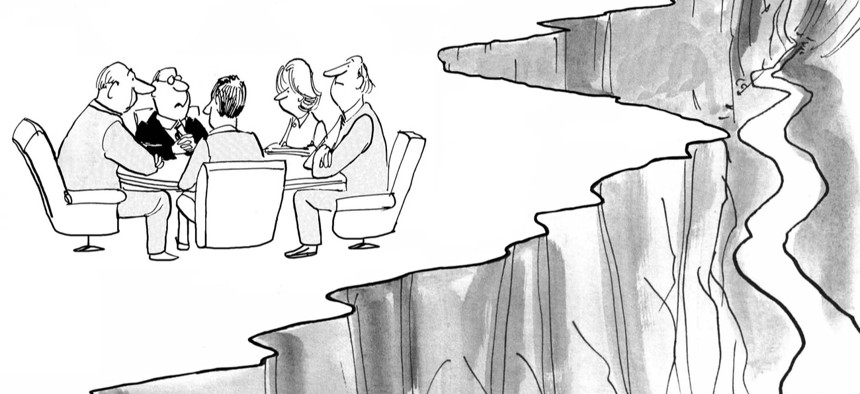One Key to Making a Leadership Offsite a Success: Logic Models
It's a way to weave evidence into the agenda of a leadership strategy session, providing a real chance for actionable takeaways or recommendations.
The idea behind leadership “offsites”— strategy sessions away from the incessant demands and routines of the office—is compelling: creating dedicated time for public executives to focus on the big picture. In practice, offsites (including virtual ones in a pandemic) can be tricky to pull off successfully.
One reason is because these retreats take busy leaders away from their daily duties, so the bar is already high in terms of making sure the time away is well spent. Plus, it’s not easy to design offsites so that they produce useful, actionable takeaways or recommendations.
What can help make a leadership offsite a success? It’s to weave a foundational tool of evidence-based decision-making into the agenda by using logic models. The approach has been used with positive results by a range of federal agencies and offices in recent years, employed in offsites ranging from quick half-day convenings to more in-depth gatherings of a day or two. The approach involves three main steps:
Hold a Quick Logic Model Training Session
The first step is to give participants an overview of logic models. When applied to an organization or program, a logic model uses a detailed visual representation to depict the actual or intended relationships among organizational inputs, activities, outputs and outcomes and, in doing so, helps clarify how the organization or program works—or ought to work if well designed. After the overview, it’s useful to dive into a group exercise.
To make the training fun, a suggestion is to ask participants to develop logic models for their dream summer vacations—yes, ones that imagine the pandemic being over. Each breakout group picks a destination and uses the logic model framework to identify the needed inputs, activities, outputs and outcomes for a successful getaway. The groups then share their logic models with each other.
Create Logic Models for the Organization
Now that the group has practice with logic models, the second step is to have participants build real ones for their agency, office or program. The work is usually done in breakout groups, to allow for more individual participation. Importantly, participants are also asked to use the logic models they develop to answer two questions:
- What are the most important barriers to achieving the organization’s intended outcomes?
- What near-term or longer-term changes or initiatives could help us overcome those barriers?
Share the Results and Vote on the Best Ideas
In the third step, the breakout groups reconvene and share their logic models, the key barriers they identified and their ideas for improvement. When they’re done, it’s useful to get immediate feedback from the group about which of those improvement ideas are most valuable. In a virtual offsite, that can be done with a quick online survey (asking participants, for example, to check off their favorite three ideas). In an in-person offsite, it can employ a technique like dot-sticker voting. If time allows, a final set of breakout groups can help flesh out the top vote-getting ideas.
I’ve seen firsthand how those steps within an offsite can produce valuable benefits. In one offsite of office leadership within a large federal agency, several of the breakout groups noted that a lack of communication and coordination between teams and between teams and leadership was a challenge to the outcomes identified in their logic models. One of the groups proposed a new inter-team council that could help provide better coordination. That idea was one of the top vote-getters in the quick-feedback survey. Within a few weeks of the offsite, leadership gave a green light to the council. It was launched successfully soon after and continues today.
There are, of course, other best practices for leadership offsites, including ensuring that the purpose is clear and using a mix of activities—these could include speeches, large-group discussions, small-group breakouts—to keep the session lively.
But beyond those evergreen suggestions, developing logic models within a leadership offsite has an important benefit: It encourages participants to look carefully and realistically at what the organization does, what it’s aiming to do and how well it’s doing it. Moreover, by using logic models to identify and prioritize concrete ideas for improvement, it ensures that the offsite produces something tangible. Then it’s up to senior leaders to ensure that useful ideas for improvement get their support and become a reality.
Andrew Feldman is a director with Grant Thornton Public Sector LLC and also hosts the Gov Innovator podcast. He served as a special adviser on the evidence team at the White House Office of Management and Budget in the Obama administration.




